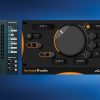
Review: Audient ID44 Audio Interface
Audient’s iD series has always packed console heritage into a box. But now, with dual ADAT expansion, you get a console’s worth of expansion with it.
Audient’s history is steeped in large-format consoles and time-tested circuit designs; the founders both worked at Soundcraft, before starting DDA consoles. While consoles are still a big part of the Audient catalogue, the company has done especially well for itself by pouring its ‘world class’ DNA into attainable interfaces designed to appeal to home studio enthusiasts. The iD interface series is the vehicle that put Audient designs within reach of the commoner.
Starting with a cute two-input box, the iD4, the family has grown steadily into what we have today — the new iD44. It’s a 20-input/24-output USB-C interface with four of Audient’s staple Class A preamps designed by founder David Dearden. The iD44 is the first in the series to have dual-ADAT inputs lending it an extra 16 digital channels of potential expansion.
PHYSICALITIES
Of the four built-in preamps, I love that there are insert points on the first two. Put that old compressor back to work! Channels 1 and 2 have DI inputs on the front, which override the XLR combo connectors. Each preamp has switchable +48V phantom power, -10dB pad, HPF at 100Hz, and basic signal/peak dual-LED metering. Over to the right on the top panel is the monitoring section. The multipurpose push-button knob controls monitor level by default and when you turn it, the central LED meter shows where the volume is.
Handily, Audient’s ScrollControl feature allows the wheel to be used for other functions within your DAW. Two sets of speaker outputs let you A/B between your favourite pairs of monitors. The two optical ports can be used for either S/PDIF or ADAT. There’s a Word Clock output for syncing and a USB-C port for your computer (thankfully a USB-C to USB Type A cable is included).
Audient states the dynamic range on the output DAC is an impressive 126dB, and it sure sounds good the first time I heard it through my monitors. The ADC will give you 121dB dynamic range on the inputs. The DAW roundtrip latency figures given by Audient go from 5.6ms at 44.1k to 4.2ms at 96k, with a 32-sample buffer. Want quicker? Simply monitor directly from the iD DSP mixer; Audient quotes a round-trip of 0.677ms at 44.1k.

YOUR iD PLEASE
Once downloaded, the iD Mixer App (which is part of the driver download) sits in your top system tray on macOS. It initially caught me out, because no window appeared when I opened the app. Incidentally, the first question in the Audient FAQs section is “Why isn’t my iD Mixer Application showing up?” Click on the iD logo in your taskbar and hit Show Mixer to reveal the application.
The Mixer App GUI is neat and tidy, allowing you to create up to four cue mixes from the inputs. Show or Hide the Mic/Optical/DAW channels in the mixer using the three buttons on the top right. The workflow couldn’t be easier although I would’ve liked to see some colour in there — the dark grey app looks kinda dull. Unfortunately input channels can’t be reordered within the mixer to put your most-used inputs within easy reach. It just means you have to scroll around a bit if you go the ADAT route.
A System Panel gives you a matrix-style routing view where you can assign mixes to any output. Here you can also switch the Digital Input and Output between two-channel S/PDIF or eight-channel ADAT, trim the Dim and Alt Speaker Output levels, set the clock source, and set the Talkback mic source (either the built-in mic or an input of your choice). Some of these settings are already assigned to the three Function buttons on the interface but you can reassign any of them by right-clicking the setting in the Mixer App and selecting F1, F2 or F3. Things are laid out very clearly and I like that there are keyboard shortcuts to display and hide the go-to views within the Mixer App. I really dig the real-time scrolling graph under each mix for a visual cue of the audio passing through.
NEED TO KNOW

DUEL TIME
The best way to know how good something is is to compare it to something you already know. My Antelope Audio Zen Tour has a lot in common with the Audient iD44. Both have four onboard preamps, though the Audient’s topology is discrete and the Antelope uses an IC chip. Both offer built-in talkback mics, two headphone outputs, two DI inputs, two main outs, and nearly identical desk footprints. Other than DSP (the Zen Tour has it), the main difference is price; the iD44 is half the cost of the Zen Tour. Let’s see how they match up in sound.
Hearing the two preamps side by side on finger-picked acoustic guitar was fascinating. I didn’t exceed 30dB of gain from the Zen Tour for a happy level (just under half its available 65dB) whereas the gain pot on the iD44 was at three o’clock (max is five o’clock) to pull the same level. Audient hasn’t printed actual dB values on the box — only 1 to 10 — but we do know there’s 60dB, all up. A big slice of that is in the final micro twist of the pot, hence the pot sitting disproportionately high for my medium gain settings. The good news is it stays pretty quiet the whole way.
Lining up and A/B-ing the DAW tracks revealed subtle differences between the two. The Zen Tour pres stayed glassy and clear up into the extreme highs while the iD44 seemed to roll off a bit. However, Audient’s discrete preamp circuitry had a more forward sound with accentuated mids. It’s a nice, solid sound that’s easy to mix.
I do miss having a comfort reverb or some basic DSP inside the mixer app, though — something I’ve come to appreciate in Antelope gear. Another difference is it’s harder to set and recall gain settings when, like me, you’re used to doing it on-screen with digitally-controlled preamps… but that’s not a biggie.
Stacking more instruments with the two interfaces uncovered more of the same pattern — clean and zingy with the Zen Tour, full and upfront with the iD44. Considering its sub-$1k price tag, the iD44 has a rich and classy tone that’s miles ahead of what you would’ve gotten in ‘just another’ USB interface five years ago. It’s the Audient console heritage shining through and it’s certainly what makes the iD boxes attractive.
The whole iD44 experience is top notch. The switches and knobs are solid, no wobbly bits or cheap plastic. Throwing a few monitor mixes together and routing them is super easy in the iD Mixer App. The headphone outputs are punchy enough to drive high-impedance open-backs and the three user-definable function buttons are the cherry on the workflow cake. The unit is a great size for tracking on the road. Plus, if the occasion calls for it, you can easily expand your inputs via the ADAT ports. What’s not to love!






























RESPONSES